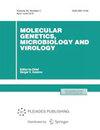Markers of Viral Hepatitis B in Blood–Plasma Samples of the Indigenous Population of the Far North of Russia. HBV Genotypes and HBsAg Subtypes
IF 0.3
4区 生物学
Q4 BIOCHEMISTRY & MOLECULAR BIOLOGY
引用次数: 2
Abstract
Hepatitis B is a major public health problem worldwide. The indigenous population of remote regions with harsh living conditions, such as the Far North of Russia, with possibly unique genetic mutations in the local strains of this pathogen, remains poorly studied. The aim of the study was to determine the prevalence of serological HBV markers in blood–plasma samples of the population of the Far North of Russia and to determine HBV genotypes and HBsAg subtypes in blood–plasma samples containing HBsAg. We studied 702 blood–plasma samples taken from the indigenous population (Tundra Nenets) of the village of Gyda in the Tazovsky district of the Yamalo-Nenets autonomous okrug (YaNAO) (north of the Gydan Peninsula). Detection of serological HBV markers—HBsAg, anti-HBs, and anti-Hbcore—was carried out using JSC Vector-Best reagent kits. HBV genotypes and HBsAg subtypes in the samples were determined according to our own original procedure with monoclonal antibodies and by classical molecular-biological methods. The prevalence of HBsAg in the entire sample was 0.4% (3/702). For the subgroup of samples (persons older than 15 years during the first two expeditions, 300 samples), an extended analysis of the markers was carried out. The following frequencies were determined for them: HBsAg, 0.7% (2/300); anti-HBs, 63.7% (191/300); and anti-HBcore, 11.3% (34/300). HBV statuses were established for this subgroup: the presence of HBV infection (0.7%), past hepatitis B infection (9.3%), and immunity as result of vaccination (54.3%). Genotype D was established for two samples containing HBsAg (subtypes ayw2 and ayw3); the results of the two used methods coincided. The prevalence of HBsAg in the Tazovsky and adjacent Purovsky districts (the main population being Nenets, previously published data) differed (0.4% vs. 1.7%, p < 0.05), presumably due to vaccination (samples of the Purovsky district were collected almost 20 years earlier), as well as the distribution of HBV genotypes. The Tazovsky district of YaNAO is now a low endemic region in terms of HBV infection. The HBV isolates belong to the most common HBV genotype D in the Russian Federation (HBsAg subtypes ayw2, ayw3).俄罗斯远北地区土著居民血浆样本中乙型病毒性肝炎标志物的研究HBV基因型和HBsAg亚型
乙型肝炎是世界范围内的一个主要公共卫生问题。生活条件恶劣的偏远地区的土著居民,如俄罗斯的远北地区,可能在这种病原体的当地菌株中有独特的基因突变,但对这些地区的研究仍然很少。该研究的目的是确定俄罗斯远北地区人群血浆样本中血清学HBV标志物的流行情况,并确定含HBsAg的血浆样本中HBV基因型和HBsAg亚型。我们研究了采自亚马尔-涅涅茨自治区(YaNAO)(格丹半岛北部)Tazovsky区Gyda村土著居民(苔原涅涅茨人)的702份血浆样本。采用JSC Vector-Best试剂盒检测血清HBV标志物hbsag、anti- hbbs和anti- hbcore。样品中的HBV基因型和HBsAg亚型根据我们自己的原始程序用单克隆抗体和经典的分子生物学方法测定。HBsAg阳性率为0.4%(3/702)。对于样本亚组(前两次探险中年龄超过15岁的人,300个样本),对标记进行了扩展分析。他们的频率测定如下:HBsAg, 0.7% (2/300);anti-HBs, 63.7% (191/300);anti-HBcore为11.3%(34/300)。确定该亚组的HBV状态:存在HBV感染(0.7%),既往乙型肝炎感染(9.3%),接种疫苗后免疫(54.3%)。两份含HBsAg样本(ayw2和ayw3亚型)建立基因型D;两种方法的结果是一致的。Tazovsky和邻近的Purovsky地区(主要人群为涅涅茨人,先前公布的数据)的HBsAg患病率不同(0.4% vs. 1.7%, p < 0.05),可能是由于疫苗接种(Purovsky地区的样本是在近20年前收集的)以及HBV基因型的分布。YaNAO的Tazovsky区现在是HBV感染的低流行区。HBV分离株属于俄罗斯联邦最常见的HBV基因型D (HBsAg亚型ayw2, ayw3)。
本文章由计算机程序翻译,如有差异,请以英文原文为准。
求助全文
约1分钟内获得全文
求助全文
来源期刊

Molecular Genetics, Microbiology and Virology
BIOCHEMISTRY & MOLECULAR BIOLOGY-MICROBIOLOGY
CiteScore
0.70
自引率
0.00%
发文量
8
审稿时长
>12 weeks
期刊介绍:
Molecular Genetics, Microbiology and Virology is a journal that covers most topical theoretical and applied problems of molecular genetics of pro- and eukaryotic organisms, molecular microbiology and molecular virology. An important part the journal assigns to investigations of the genetic apparatus of microorganisms, searching for forms of genetic exchange, genetic mapping of pathogenic causative agents, to ascertainment of the structure and functions of extrachromosomal factors of heredity and migratory genetic elements, to theoretical studies into the mechanisms of genetic regulation. The journal publishes results of research on molecular and genetic bases of an eukaryotic cell, functioning of chromosomes and chromatin, nature of genetic changes in malignization and a set of hereditary diseases. On the pages of the journal there is covered the formulation of molecular bases of virology including issues of integration of viral and cellular genomes, and issues of persistence. The journal plans to put materials on genetic engineering, envisaging synthesis and isolation of genes from natural reservoirs, creation of plasmid- and virus-based vector, production of recombinant DNA molecules, the creation of Gene Banks for Microbes, animals, and human; and also on biotechnological production of hormones, components of antiviral vaccines, diagnostic and therapeutic preparations.
 求助内容:
求助内容: 应助结果提醒方式:
应助结果提醒方式:


